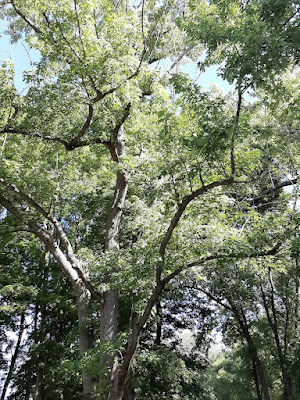Here's the route we took today:
We took off pretty early from Paducah, drove through a weird highway interchange where those coming from our side drove on our left while those crossing our lanes from the other way drove on THEIR left, just as if we were all in England -- and then the lanes laced back over each other again, just like a square dance, and switched everybody back onto the right where they belonged.
Then we drove a little way westward through green suburbs, where, with Dad's help in stopping the car strategically to let me take pictures, I figured out that the mysterious pink-flowered trees I've been seeing along the edge of the woods for the past couple of days are mimosas, also known as Persian Silk trees. Now, isn't that an evocative name? Unfortunately, they turn out to be invasive escapees from gardens that were brought from Asia and have colonized much of the southeast. But they are just beautiful, vase-shaped trees with cascading ferny leaves and pink flowers made of fine silky strands, arranged in curving arcs overhead. Apparently they're fragrant, too, though I didn't get close enough to establish that for myself.

Then we found ourselves in this very interesting spot:
That's the confluence of the Ohio and Mississippi rivers. The blue line is us, driving from Kentucky, right to left on the map, over the Ohio River into Illinois. Then, almost immediately, we crossed the Mississippi into Missouri. Three states and two great rivers in, maybe, five minutes. Gorgeous!


Dad saw a sign for a nature reserve and turned onto a narrow gravel road crossing fields of soybeans and Vidalia onions (or so said Google Lens, though it may well have been confused). We drove for quite a while and finally bumped over a levee and down into Bird's Blue Hole, a conservation area created when the Army Corps of Engineers blew up a levee to protect Bird's Point from a flood. When the flood burst through the opening, the surging waters dug a huge hole that is now a muddy, sleepy little lake full of fish and surrounded by shady southern trees.
From there, we wandered onto back roads near the Mississippi. For a while we were stuck behind an enormous farm machine of some kind that trundled slowly along, taking up both lanes, until eventually it grudgingly moved over to let us pass.

Next, we found our way to New Madrid, Missouri (pronounced New MAD-rid, with MAD rhyming with BAD or SAD). The town is famous for a positively enormous series of earthquakes in the early 1800s. According to the New Madrid website, "[f]rom December 16, 1811 through March of 1812 there were over 2,000 earthquakes in the central Midwest, and between 6,000-10,000 earthquakes in the Bootheel of Missouri where New Madrid is located near the junction of the Ohio and Mississippi Rivers." Survivors said that the Mississippi briefly ran the opposite way, sweeping riverboats back the way they'd come, there were sudden 30-foot waterfalls in the river, the town dropped 12 feet and was submerged below flood waters and destroyed, and the river permanently changed its course through that area. The quakes "were felt as far away as New York City, Boston, Montreal, and Washington D.C. President James Madison and his wife Dolly felt them in the White House. Church bells rang in Boston."
The town is also famous for a 60-year-long blood feud between two families and for a Civil War battle in which, among other things, Union soldiers dug a canal through a swamp to bypass an island known as Number 10 to allow ironclads to sneak past Confederate gun batteries in New Madrid. The picture shows a submersible saw, now exhibited in a Town park beside the river, that was used to saw down trees underwater while the canal was being cleared.
But we were there to see the Mississippi, and we did. New Madrid has an observation deck where we saw what seemed to be a grounded barge wedged at an angle to the bank, watched a tugboat push other barges laden with mysterious covered cargo up the river, and saw huge trees scattered like toothpicks along the shoreline, left by some recent flood. Floods seem to be the major stories and formative events all along the river.After that, we drove a long, long way through Arkansas over pretty much featureless Interstate clogged with giant trucks. Eventually we found ourselves here in Hope, Arkansas,the birthplace of William Jefferson Clinton. We just got back from a late-night swim in the outdoor motel pool, water even warmer than the warm air, like floating in a dream, while the giant trucks kept thundering past on the nearby highway. Not anywhere either of us ever expected to find ourselves, but a weirdly lovely little niche of an evening nonetheless.







No comments:
Post a Comment